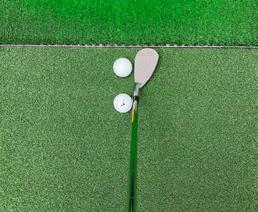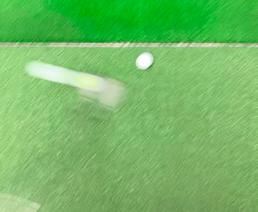
2 minute read
Two of the Best Drills You’ve Never Seen Before
Bruise the Ground with Short Game Shots (1A & 1B).
So many beginner golfers have a low point control problem, and one of the best ways to get them to hit the ground (without digging) is to ‘bruise’ the ground when they hit short shots. This may involve keeping the arms straight or slightly hinging the club, but finding a way to have a new golfer become comfortable with hitting the ground is an invaluable lesson. This will also help from keeping your elbows from separating, one of the greatest differentiators between professional golfers and amateurs. As soon as the lead wrist begins to extend (rather than flex), your lead elbow will automatically get into that poor ‘chicken wing’ position and will result in inconsistent contact and ball flight.
Advertisement




Hit the Inside Ball (2A & 2B). This is a concept that many of my students struggle with. Many players have a tendency to associate good contact with the heel of the club. This contact can (at times) feel good, but is dangerously close to the hosel of the club, and no one likes to hit it there. This drill is designed to get someone to miss the ball they intend to hit. Take two golf balls and set them up next to each other perpendicular to your target. Address the ball farther away from you and take small, slow swings trying to hit the inside ball. This will develop the necessary move to avoid that heel contact. Heel shots usually result in a player getting too close to the ball from where they were at address. The motion you want to achieve is having the center of your pelvis to be out over your heels as you make contact with the ball. Another thought is having your toes slightly off the ground to keep your pelvis from thrusting toward the ball.
TJ Sullivan is a PGA Master Professional in Teaching and Coaching. He recently made the 2020/21 Golf Digest Best Young Teachers and 2019/20 as well as 2022/23 Golf Digest Best Teachers in the State lists. He is a four time Illinois PGA Teacher of the Year Nominee and has taught over 30,000 lessons in 15 years with GOLFTEC. He also is a six time Outstanding Achievement in Instruction Award winner and a Coastal Carolina University PGM Alumnus.
WWay back in the late 1970s, indoor golf experienced a technology surge when simulated golf courses were projected using a slide projector and movie screen to emulate a real golf course experience. Fast forward nearly 50 years and make a right turn into the Oak Brook Promenade parking lot of the Game of Irons indoor golf center, and you are immediately blown away by the size and scope of this next-generation entertainment experience. Completely unlike the basement operations of the past, Game of Irons is located in a two-story, 18,300 sq. ft. space featuring 16 simulator bays. And the bays themselves are wide enough to provide plenty of room for as many as six to eat, drink, be merry and hit golf balls.
“Our goal was to exceed the expectations of our guests,” said president Jin Park in a December interview. “Before we built Game of Irons, we looked at the indoor golf marketplace and tried to improve every aspect of the simulator golf experience.” That starts with the quantity of simulated golf courses available to be played—200—and extends through the exceptionally crisp images of each golf course depicted on the screens, and even goes multiple steps further on how balls are automatically dispensed on the tees. Even the hitting surfaces are special as three different surfaces emulate actual conditions on tees, fairways, rough, and sand. And just when you think the center’s Golfzon simulator technology is as good as it gets, the platform



